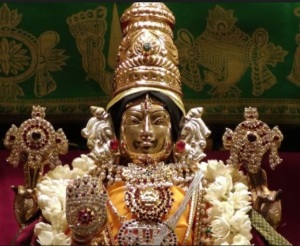SrI: SrImathE SatakOpAya nama: SrImathE rAmAnujAya nama: SrImadh varavaramunayE nama:

Sāmrājya Paṭṭābhiṣekam
The Gadyatrayam is a delight to devotees. In the section, starting akhilaheyapratyanīka in Śaraṇāgati Gadyam, Swami Emperumānār describes the outstanding nature of the Lord, His divine form, His auspicious attributes, His divine and beautiful ornaments, His divine weapons, and His divine consorts.
 While describing His divine ornaments starting “svocita-vividha-vicitrānanta …” come the words “kirīṭa makuṭa cūḍāvataṃsa”. All the three words kirīṭa, makuṭa and cūḍāvataṃsa carry the same meaning. They refer to His crown or abhiṣekam. A question arises as to why Swami Emperumanar employs three words to convey the same meaning.
While describing His divine ornaments starting “svocita-vividha-vicitrānanta …” come the words “kirīṭa makuṭa cūḍāvataṃsa”. All the three words kirīṭa, makuṭa and cūḍāvataṃsa carry the same meaning. They refer to His crown or abhiṣekam. A question arises as to why Swami Emperumanar employs three words to convey the same meaning.
Each word can be taken to explain one section of the crown. kirīṭa stands for the base of the crown that goes around the head. makuṭa denotes the portion of the crown that extends above the head. cūḍa refers to the jewel that hangs from the crown and adorns the forehead. avadamsa is the portion of the ornament that is shaped like a flower over the ears. This explanation is found in Svami Periyavācchān Piḷḷai’s commentary.
Some devotees who have witnessed the utsavams of Lord Namperumal have seen Him various types of abhiṣekams. They might think that the different words refer to different crowns adorned by the Lord.
In the current context, where we are experiencing the works of Swami Emperumanar through the words of the Azhwars, it becomes pertinent to consider if Azhwars have experienced the Lord in this fashion.
In Thiruviruththam, Azhwar says,
“pāraḷanda pērarasē! emvisumbarase! emmai nīththu vañchiththōrarasē!”.
Azhwar reckons the Lord thrice as ‘arasē! arasē! arasē!’”
Each of the three words has a separate meaning.

Lord Trivikrama
pāraḷanda pērarasē! refers to the Lord as the king on account of His saulabhyam. He placed His divine feet upon the heads of everyone in this world during His incarnation of Trivikrama.
 emvisumbarase! refers to the Lord as the king on account of His paratvam. He lords over the Nitya Sūris in Vaikuṇṭha.
emvisumbarase! refers to the Lord as the king on account of His paratvam. He lords over the Nitya Sūris in Vaikuṇṭha.

emmai nīththu vañchiththōrarasē! refers to the Lord as the king on account of His praṇayitvam or love for Azhwar due to which He mingles with or parts with Azhwar at different times.
The Lord’s three ways of being the king is referred by Swami Azhagiya Maṇavāḷa Perumāḷ Nayanār in Acārya Hṛdayam as
“pāraḷandha-vennum mūṇḍṛu mūḍikkuriya iḷavarasukku …”
Swami Emperumanar can be seen echoing the words of Azhwar to celebrate His Lordship (Sāmrājya Paṭṭābhiṣekam) from saulabhyam, paratvam and praṇayitvam in kirīṭa, makuṭa and cūḍāvadamsa.
A doubt can be raised here if praṇayitvam is not part of saulabhyam itself. It is true that praṇayitvam can be experienced as a subset of saulabhya guṇams. However, it is a very special guṇa of the Lord and deserved to be experienced separately. Saulabhyam is generic and applies to all souls. When the Lord placed His divine feet upon the heads of all, He did not discriminate between them. However, His praṇayitvam is experienced only in the case of Azhwar and is a special guṇam. Saulabhyam is common to even those who are engrossed in material pleasures as in
“uṇḍiyē uḍaiyē uganthoḍum immaṇḍalaththor”.
However, His praṇayitvam is manifest in the special case of Azhwar to whom
“uṇṇum sōr parugu nīr thinnum veṭṛilaiyumellām kaṇṇan”.
It is customary to experience such special qualities even when they are conveyed by other generic terms. Swami Emperumanar himself gives us another example in Sri Bhashyam.

At the very outset, he shows that the Para Brahman, Srinivasa is “akhilabhuvana-janma-sthema-bhaṅgādilīlaḥ” or one who creates, protects and destroys all the worlds as if by sport. Then, again He is regarded as “vinata-vividha-bhūta-vrāta-rakṣaika-dīkṣaḥ” which celebrates Him as the protector of His devotees. Though His nature as the protector is already apparent in “sthema” previously, it is repeated again. In “akhila-bhuvana-sthema-līlaḥ”, He is regarded as the protector of the entire world in general. In ” vinata-vividha-bhūta-vrāta-rakṣaika-dīkṣaḥ”, His special form of rakṣaṇam with respect to His devotees is celebrated. In the same manner, praṇayitvam is experienced as a special form of saulabhyam.
adiyen ranganatha ramanuja dasan
archived in https://srivaishnavagranthams.wordpress.com/
pramEyam (goal) – http://koyil.org
pramANam (scriptures) – http://granthams.koyil.org
pramAthA (preceptors) – https://guruparamparai.wordpress.com
SrIvaishNava Education/Kids Portal – http://pillai.koyil.org

Pingback: ड्रमिडोपनिषड् प्रभाव् सर्वस्वम् 11 | SrIvaishNava granthams in hindi
Pingback: த்ரமிடோபநிஷத் ப்ரபாவ ஸர்வஸ்வம் 11 | SrIvaishNava granthams in thamizh
Pingback: த்ரமிடோபநிஷத் ப்ரபாவ ஸர்வஸ்வம் 12 | SrIvaishNava granthams in thamizh
Pingback: ద్రమిడోపనిషత్ ప్రభావ సర్వస్వం 11 | SrIvaishNava granthams – Telugu